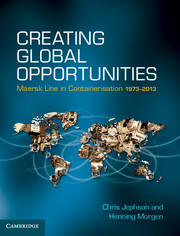Book contents
- Frontmatter
- Dedication
- Contents
- List of figures
- List of tables
- List of Economist Intelligence Unit data
- List of boxes
- Acknowledgements
- Glossary
- Prologue
- 1 ‘Per Aspera Ad Astra’
- 2 The Coming Revolution
- 3 The Decision
- 4 Building the Base (1978–1984)
- 5 Planning the Next Steps (1984–1987)
- 6 Laying the Foundations for Expansion (1987–1990)
- 7 The 1990s
- 8 The Acquisition Trail (1992–1998)
- 9 1999 A Year of Developments and Acquisitions
- 10 Into the New Millennium (2000–2005)
- 11 P&O NedLloyd (2005–2007)
- 12 A New Strategy (2008–2013)
- Epilogue
- Notes and References
- Index
4 - Building the Base (1978–1984)
Published online by Cambridge University Press: 05 April 2014
- Frontmatter
- Dedication
- Contents
- List of figures
- List of tables
- List of Economist Intelligence Unit data
- List of boxes
- Acknowledgements
- Glossary
- Prologue
- 1 ‘Per Aspera Ad Astra’
- 2 The Coming Revolution
- 3 The Decision
- 4 Building the Base (1978–1984)
- 5 Planning the Next Steps (1984–1987)
- 6 Laying the Foundations for Expansion (1987–1990)
- 7 The 1990s
- 8 The Acquisition Trail (1992–1998)
- 9 1999 A Year of Developments and Acquisitions
- 10 Into the New Millennium (2000–2005)
- 11 P&O NedLloyd (2005–2007)
- 12 A New Strategy (2008–2013)
- Epilogue
- Notes and References
- Index
Summary
‘Do you know what freight is?’ McLean would ask a visitor. ‘You can look it up in the dictionary, but I’ll tell you. It’s something added to the cost of the product.’
All his life he worked to make that ‘something added’ as low as possible.
O. E. Allen, The Box, An Anthology Celebrating 50 Years of ContainerisationThe world container ship capacity in 1970, according to Containerisation International, was 195,362 TEU (20-foot-equivalent container units). By 1985, this number had passed two million. When Maersk Line entered containerisation in 1975, it had two ships built specifically for transporting containers – the Adrian Mærsk, the first A-class ship, and the Svendborg Mærsk. Six years later, it had 25 cellular container ships in its network and was operating just under 5 per cent of the world’s container fleet. Only Sea-Land and Hapag Lloyd were larger. How these developments took place is the next part of this story.
The agents’ meeting, 1976
Very early in 1976 Maersk Line’s management was greatly concerned about the results of the new container service. To that end, a meeting was called in Copenhagen attended by representatives of agents from the United States, Indonesia, Thailand, Singapore, Hong Kong, Taiwan and Japan. They met to discuss ways and means to turn the results around. In preparation for the meeting, Birger Riisager, responsible for Finance and Systems, sent the offices details of the original 1969 Stanford Research Institute study. The forecasts for 1976 received from the agents departed widely from the Crash Committee projections for 1976 and 1977, and the discrepancies needed to be addressed. The outbound numbers from the United States to the Far East were a particular concern. Volumes were about 10 per cent below the original projections, while freight rates were ‘substantially lower’. It was clear that ‘the very slow outward market had made all carriers look for lower-paying commodities’.
- Type
- Chapter
- Information
- Creating Global OpportunitiesMaersk Line in Containerisation 1973–2013, pp. 84 - 123Publisher: Cambridge University PressPrint publication year: 2014



